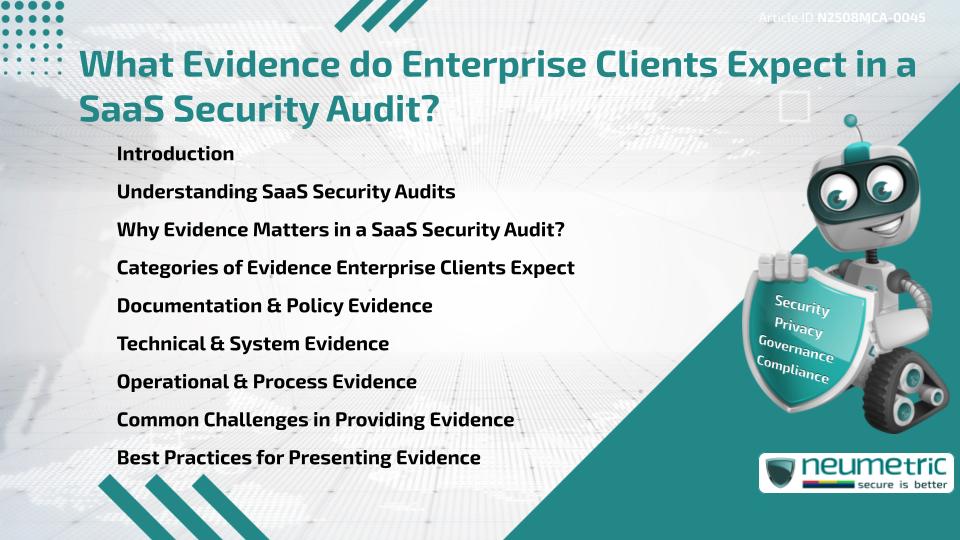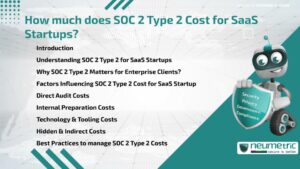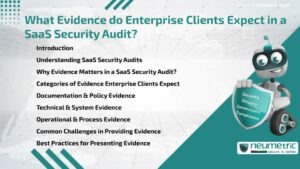Table of Contents
ToggleIntroduction
Enterprise clients expect clear & verifiable proof of security practices during a SaaS security Audit. Understanding what Evidence to provide in SaaS Security Audit helps vendors build trust & meet compliance needs. Evidence typically includes Policies, technical configurations, operational records & monitoring practices. By supplying accurate documentation, system outputs & process records, SaaS Providers can assure enterprise clients that Data Protection & compliance obligations are met.
Understanding SaaS Security Audits
A SaaS security Audit is an Independent Review of a provider’s Security Controls & processes. It helps verify that Customer Data is safeguarded against Threats such as unauthorised access, data loss or service disruption. Enterprise clients often use these audits to assess Risks before committing to long-term vendor relationships. Unlike small-scale security checks, these audits follow recognised frameworks like SOC 2, ISO 27001 or HIPAA, which require structured Evidence.
Why Evidence Matters in a SaaS Security Audit?
Evidence is essential because it transforms claims into verifiable facts. Enterprise clients do not accept verbal assurances; they require documentation & records that can be tested & reviewed. Providing strong Evidence builds credibility, reduces delays in due diligence & shows that Security Controls are not only designed but also operating effectively. Without Evidence, even a well-implemented security program can appear incomplete.
Categories of Evidence Enterprise Clients Expect
Evidence in a SaaS security Audit usually falls into three categories: documentation, technical configurations & operational records. Documentation proves the existence of security frameworks. Technical Evidence shows systems are set up correctly. Operational Evidence demonstrates that processes are consistently followed. Together, they create a complete view of security effectiveness.
Documentation & Policy Evidence
Enterprise clients expect clear documentation of Security Policies, standards & procedures. Examples include:
- Information Security Management System [ISMS] manuals
- Access Control & data handling Policies
- Business Continuity & Disaster Recovery plans
- Vendor Risk Management records
These documents demonstrate Governance & accountability. For instance, a written data retention policy shows that the SaaS provider does not keep Client data longer than necessary, reducing unnecessary Risks.
Technical & System Evidence
Technical Evidence provides direct proof that systems are secured. Enterprise clients look for:
- Configuration screenshots of firewalls, intrusion detection systems & encryption settings
- Logs from identity & access management tools
- Results from Vulnerability scans & penetration tests
- Proof of regular system patching & updates
This Evidence confirms that technical safeguards are active. A log showing multi-factor authentication use, for example, verifies that User access is controlled in line with policy.
Operational & Process Evidence
Operational Evidence demonstrates that daily activities align with documented Security Controls. Enterprise clients often request:
- Security training records for staff
- Incident Response logs & lessons learned
- Change management tickets
- Audit trail reports from monitoring systems
These records reveal how security practices function in real-world conditions. For instance, Incident Response documentation illustrates that the provider not only has a policy but also executes it during actual events.
Common Challenges in Providing Evidence
Many SaaS Providers struggle with collecting & presenting the right Evidence. Challenges include:
- Incomplete documentation due to rapid scaling
- Limited visibility across distributed systems
- Difficulty translating technical Evidence into business language
- Overlap or duplication between compliance frameworks
These issues can frustrate enterprise clients & prolong the Audit process. Addressing them requires planning, central Evidence repositories & cross-team coordination.
Best Practices for Presenting Evidence
SaaS Providers can streamline security audits by following Best Practices:
- Maintain up-to-date Policies & link them to specific Security Controls
- Automate collection of system logs & configuration Evidence
- Use a central platform to organise & store Audit materials
- Map Evidence to compliance frameworks for easier validation
- Provide context & explanations with technical outputs to aid non-technical reviewers
These practices show enterprise clients that the provider is proactive, organized & transparent.
Conclusion
Enterprise clients expect more than Policies on paper, they also require proof that Security Measures are consistently applied. Knowing what Evidence to provide in saas security Audit is key to passing Client reviews & maintaining trust.
Takeaways
- Evidence proves that Security Controls are implemented & effective.
- Clients expect documentation, technical outputs & operational records.
- Organised & well-presented Evidence builds trust & accelerates audits.
- Best Practices include automation, central repositories & Framework mapping.
FAQ
What Evidence to Provide in SaaS Security Audit for enterprise clients?
Policies, technical configurations & operational records such as logs, training records & Incident Response reports.
Why do enterprise clients need Evidence in a SaaS security Audit?
They require verifiable proof to confirm that security claims are accurate & controls are effective.
What role do Policies play in a SaaS security Audit?
Policies serve as Governance documents that establish security expectations & practices across the Organisation.
Can technical Evidence alone satisfy a SaaS security Audit?
No. Technical Evidence must be supported by documentation & operational records to provide a complete picture.
How can SaaS Providers prepare Evidence in advance?
By maintaining up-to-date documentation, automating system log collection & organising materials in a central repository.
What challenges do providers face in offering Audit Evidence?
Common issues include incomplete documentation, lack of visibility & difficulty translating technical details for business audiences.
Which compliance frameworks guide SaaS security audits?
Popular frameworks include SOC 2, ISO 27001 & HIPAA, each requiring structured Evidence of controls.
Need help for Security, Privacy, Governance & VAPT?
Neumetric provides organisations the necessary help to achieve their Cybersecurity, Compliance, Governance, Privacy, Certifications & Pentesting needs.
Organisations & Businesses, specifically those which provide SaaS & AI Solutions in the Fintech, BFSI & other regulated sectors, usually need a Cybersecurity Partner for meeting & maintaining the ongoing Security & Privacy needs & requirements of their Enterprise Clients & Privacy conscious Customers.
SOC 2, ISO 27001, ISO 42001, NIST, HIPAA, HECVAT, EU GDPR are some of the Frameworks that are served by Fusion – a SaaS, multimodular, multitenant, centralised, automated, Cybersecurity & Compliance Management system.
Neumetric also provides Expert Services for technical security which covers VAPT for Web Applications, APIs, iOS & Android Mobile Apps, Security Testing for AWS & other Cloud Environments & Cloud Infrastructure & other similar scopes.
Reach out to us by Email or filling out the Contact Form…





